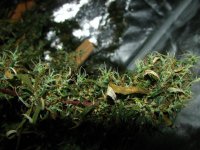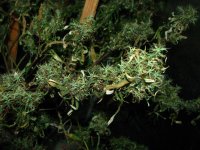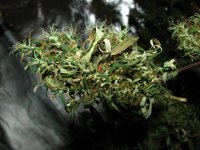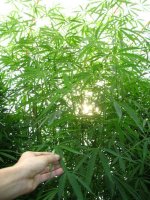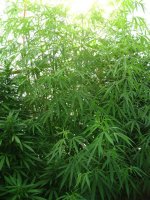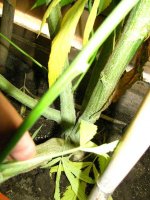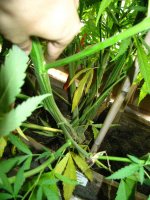-
ICMag with help from Landrace Warden and The Vault is running a NEW contest in November! You can check it here. Prizes are seeds & forum premium access. Come join in!
You are using an out of date browser. It may not display this or other websites correctly.
You should upgrade or use an alternative browser.
You should upgrade or use an alternative browser.
Info on The Real Seed Company?
- Thread starter Koondense
- Start date
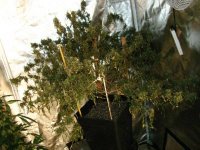
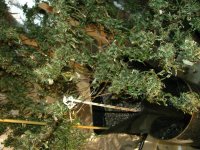
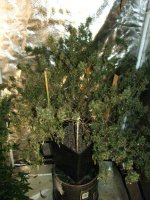
FerNanda Devi 90 Days indoor
10Lt, summer indoor grow with LED Light
33-40ºC ,35-45%
the flower quantity is very high,
sativa short internod
for more resin production she prefers winter-spring grow with more humid wet ambient and cold night
Very resistant and adapts to different types of environments
pure sativa from india charas plant
Last edited:
for sure, FerNanda is my special girl, daytime smoke
the redish-purple steam is a full of thricomes,
is difficult show in the photo but when you work with her ,my fingers are fully sticky trichome resin,
real charas plant....
the redish-purple steam is a full of thricomes,
is difficult show in the photo but when you work with her ,my fingers are fully sticky trichome resin,
real charas plant....
I am wondering if something like a root shield or mycorrhizae pre treatment of field seeds would be better than h202 pre treatment and/or inoculating the media used to germinate/raise plugs.
Yes maybe soaking seeds in mycorrhizae though I'm not sure spores would be helpful. But I'm concerned with H2O2 also as you never know which wrong signal it could send to the tiny germ sleeping inside the shell.
Probably somewhere in the depths of IC there is a protocole to be found, never seen it.
Curently I have 4 small Manipuri seedlings growing, they already look so wild compared to their others NLD neighboors in the box.
Probably somewhere in the depths of IC there is a protocole to be found, never seen it.
Curently I have 4 small Manipuri seedlings growing, they already look so wild compared to their others NLD neighboors in the box.
hi there
I think there are many factors involved in how long field collected seeds remain viable for, including strain type
for most Himalayan strains, I've now decided on a policy of taking them off the site after 12 months
but ganja strains and also Afghan / Hindu Kush strain seeds seem to last better
it's not clear to me what the factors are
but I'm not interested in messing about with stuff like hydrogen peroxide
incidentally, I've seen Himalayan seeds that stayed dormant in soil for several years only to germinate into vigorous plants... same goes for ganja cultivar seeds
I think there are many factors involved in how long field collected seeds remain viable for, including strain type
for most Himalayan strains, I've now decided on a policy of taking them off the site after 12 months
but ganja strains and also Afghan / Hindu Kush strain seeds seem to last better
it's not clear to me what the factors are
but I'm not interested in messing about with stuff like hydrogen peroxide
incidentally, I've seen Himalayan seeds that stayed dormant in soil for several years only to germinate into vigorous plants... same goes for ganja cultivar seeds
Curently I have 4 small Manipuri seedlings growing, they already look so wild compared to their others NLD neighboors in the box.
hi there
this may be pedantic of me, but as I'm sure you know, the Manipuri aren't in any way wild plants
they are ganja cultivars, and pretty heavily selected ones by the standards of traditional plants
in this case, there is a strongly established practice in the Imphal region of only growing from seeds that are from particularly good plants/batches of ganja
in the case of the batch of seeds I brought back, the farmer was emphatic that they had been kept specifically from a very good plant, and she was visibly reluctant to part with the particular bag of seeds I took, emphasizing that it was from a standout plant
this is born out by the reports of consistently high potency from growers who have cultivated this strain outdooors/in greenhouses in Spain and the tropics
of course, you only have to look at the bract-to-leaf ratio of the Manipuri plants to know that they havebn't been subjected to the kind of intensive selection Western hybrids have been through
but they are very much cultivars - specifically ganja cultivars - and my guess is that they are pretty consistently in the upper double-digit THC range, which you only get with many generations of fairly intensive selection
even Himalayan strains are far from being wild
that even goes for 'jungli', which is simply feral (i.e., escaped) cultivated Himalayan cannabis
just want to emphasise this, as time and again I see the adjective 'wild' getting used to describe these plants
as Vavilov pointed out, it is highly doubtful pure wild cannabis exists anywhere in the world these days - feral, escaped cannabis, yes - but not pure wild cannabis
Last edited:
Sorry I didn't mean to make think those manipuri were wild specimen, more that they look really far from our standardized indoor seeds. They took one week more to sprout than the others and when they popped out of the shell they already had a full set of real leaves spreading, they were so tiny they are going very slow, still growing this first set of leaves but they look very healthy. i think this manipuri could be a real gem to preserve or to breed with.
Chimera posted in his forum a protocol I believe as did another fellow from cray in the ancestral skunk threads.
hi there
this may be pedantic of me, but as I'm sure you know, the Manipuri aren't in any way wild plants
they are ganja cultivars, and pretty heavily selected ones by the standards of traditional heirloom plants
in this case, there is a strongly established practice in the Imphal region of only growing from seeds that are from particularly good plants/batches of ganja
in the case of the batch of seeds I brought back, the farmer was emphatic that they had been kept specifically from a very good plant, and she was visibly reluctant to part with the particular bag of seeds I took, emphasizing that it was from a standout plant
this is born out by the reports of consistently high potency from growers who have cultivated this strain outdooors/in greenhouses in Spain and the tropics
of course, you only have to look at the calyx-to-leaf ratio of the Manipuri plants to know that they havebn't been subjected to the kind of intensive selection Western hybrids have been through
but they are very much cultivars - specifically ganja cultivars - and my guess is that they are pretty consistently in the upper double-digit THC range, which you only get with many generations of fairly intensive selection
even Himalayan strains are far from being wild
that even goes for 'jungli', which is simply feral (i.e., escaped) cultivated Himalayan cannabis
just want to emphasise this, as time and again I see the adjective 'wild' getting used to describe these plants
as Vavilov pointed out, it is highly doubtful pure wild cannabis exists anywhere in the world these days - feral, escaped cannabis, yes - but not pure wild cannabis
Regarding there not likely being any truly wild cannabis left in the world, that's really sad. It also means that mankind has altered every last square inch of the original cannabis habitat at some point in time, which doesn't seem unlikely considering the lack of habitat preservation going on in regions where cannabis is suspected to originate. Makes you wonder if the same story is true for corn, squash, Cacao aka the tree that chocolate comes from (Theobroma cacao), cucumbers, watermelons....these wildtypes hold incredible diversity that can save cultivated plants from future extinction.
When you have landrace cannabis populations, they are relatively less genetically diverse compared to true wild types, but relative to modern dutch genetics or california's OG everything, landraces are a genetic goldmine!
Thank God many wild tomato populations and their relatives are found high in the mountains of South America. The terrain is very difficult to access, destroy, or use, so much of it is still pristine. I fear the same can't be said about other very important crops such as corn or squash which seem to grow in fertile alluvial/riparian zones.
This just goes to show how important it is for us as a community to preserve whatever is left. Habitat destruction is the quickest way to kill off a plant population, and to top that off, Nepal's political situation is likely causing the extinction of unique cannabis genotypes.
Last edited:
troutman
Seed Whore
Regarding there not likely being any truly wild cannabis left in the world, that's really sad. It also means that mankind has altered every last square inch of the original cannabis habitat at some point in time, which doesn't seem unlikely considering the lack of habitat preservation going on in regions where cannabis is suspected to originate. Makes you wonder if the same story is true for corn, squash, Cacao aka tree that chocolate comes from (Theobroma cacao), cucumbers, watermelons....these wildtypes hold incredible diversity that can save cultivated plants from future extinction.
When you have landraces cannabis populations, they are relatively less genetically diverse compared to true wild types, but relative to modern dutch genetics or california's OG everything, landraces are a genetic goldmine!
Thank God many wild tomato populations and their relatives are found high in the mountains of South America. The terrain is very difficult to access, destroy, or use, so much of it is still pristine. I fear the same can't be said about other very important crops such as corn or squash which seem to grow in fertile alluvial/riparian zones.
This just goes to show how important it is for us as a community to preserve whatever is left. Habitat destruction is the quickest way to kill off a plant population, and to top that off, Nepal's political situation is likely causing the extinction of unique cannabis genotypes.
It's greed that is killing the World.

Some would rather kill it off after they steal from Mother Nature so nobody else can enjoy the same.
That's why wild Cannabis plants are not common.
Regarding there not likely being any truly wild cannabis left in the world, that's really sad. It also means that mankind has altered every last square inch of the original cannabis habitat at some point in time, which doesn't seem unlikely considering the lack of habitat preservation going on in regions where cannabis is suspected to originate. Makes you wonder if the same story is true for corn, squash, Cacao aka the tree that chocolate comes from (Theobroma cacao), cucumbers, watermelons....these wildtypes hold incredible diversity that can save cultivated plants from future extinction.
When you have landrace cannabis populations, they are relatively less genetically diverse compared to true wild types, but relative to modern dutch genetics or california's OG everything, landraces are a genetic goldmine!
Thank God many wild tomato populations and their relatives are found high in the mountains of South America. The terrain is very difficult to access, destroy, or use, so much of it is still pristine. I fear the same can't be said about other very important crops such as corn or squash which seem to grow in fertile alluvial/riparian zones.
This just goes to show how important it is for us as a community to preserve whatever is left. Habitat destruction is the quickest way to kill off a plant population, and to top that off, Nepal's political situation is likely causing the extinction of unique cannabis genotypes.
@baduy - no worries, I just wanted to clarify the situation
@meizzwang - I think maybe you got the wrong end of the stick with what I was saying
the point isn't that modern development has eradicated wild plants
the point is that humans and cannabis have been interacting for so long that it is very unlikely that any cannabis populations anywhere are pure wild plants
it's more than likely that all cannabis has genes from cultivated plants in it, even in the areas of Inner Asia where it grows wild
cannabis has followed people around for thousands of years, and vice versa

